The 1996 penny is part of the Lincoln penny series, which most people consider the most popular coin in US history. While it is true that it is the smallest coin in terms of value, the Lincoln penny is fun to collect.
So, if you’re considering adding the 1996 penny to your collection, you need to read through the rest of this article. You will learn the value, history, and composition of the 1996 penny.
What Is the 1996 Lincoln Penny Made Of?
The 1996 Lincoln penny is made of copper and zinc. To be exact, that’s 97.5% zinc and 2.5% copper. This has been the same composition of the Lincoln penny starting from 1982 to this day.
When it comes to design, the obverse was designed by Victor David Brenner, while Frank Gasparro designed the reverse.
The obverse features the picture of Abraham Lincoln, the 16th president of the United States. On the reverse, you’ll find the Lincoln Memorial. Before 1959, the Lincoln penny’s reverse featured two stalks of wheat.
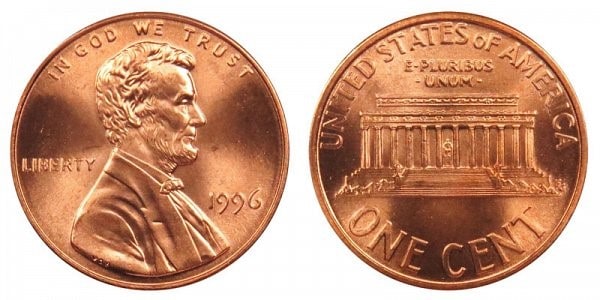
The Lincoln penny was first struck in 1909, which is also the 100th birth anniversary of Lincoln. The public warmly accepted the new penny design, and it quickly became the first widely circulated coin with an image of a president.
1996 Lincoln Penny Varieties
The 1996 Lincoln penny comes in three varieties. These are the following:
| Variety | Mint Location | Mintage |
| 1996 D Lincoln Penny | Denver | 6,510,795,000 |
| 1996 P Lincoln Penny | Philadelphia | 6,612,465,000 |
| 1996 S Proof Lincoln Penny | San Francisco | 2,525,265 |
| Total | 13,125,785,265 |
The Denver, Philadelphia, and San Francisco Mints worked together to produce more than 13 billion pennies in 1996. This shows you a great demand for Lincoln pennies in 1996.
However, although 13 billion-plus pennies sound impressive, this isn’t the highest mintage figure of the Lincoln Penny. In 1982, the mintage of the Lincoln penny reached more than 16.7 billion pieces.
On this point, it’s worth noting that the US Mint produced two types of reverse design. The close “AM” and the wide “AM.” Between the two, the close AM is more abundant.
You can confirm whether your 1996 penny is a wide or close AM. Check out the letters A and M in the word America. In the close AM type, the letters A and M are too close, almost touching each other.
Here’s what it looks like:
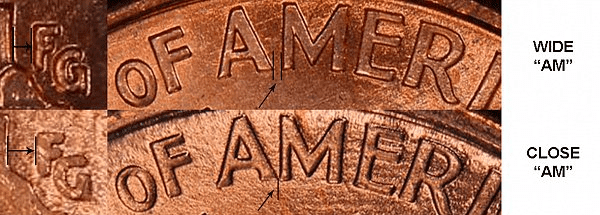
With this in mind, Let’s go through these penny varieties and learn more.
1996 P Lincoln Penny
Edge: Plain
Mint Mark: none
Place of minting: Philadelphia
Year of minting: 1996
Face Value: $0.10 (ten cents)
Price: $0.01 to $0.25 (circulated condition)
Quantity produced: 6,510,795,000
Designer: Victor David Brenner (obverse)/Frank Gasparro (reverse)
Composition: 95% copper, 5% zinc
Mass: 2.50 grams
Diameter: 19.00 millimeters
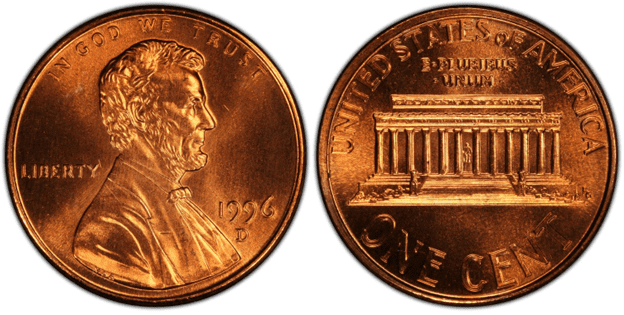
With more than 6.5 billion 1996-D pennies, you should easily find examples in both circulated and uncirculated condition. However, 1996-D pennies with a grade of MS 69 and MS 70 would be difficult to find.
1996 P Lincoln Penny
Edge: Plain
Mint Mark: none
Place of minting: Philadelphia
Year of minting: 1996
Face Value: $0.10 (ten cents)
Price: $0.01 to $0.25 (circulated condition)
Quantity produced: 6,612,465,000
Designer: Victor David Brenner (obverse)/Frank Gasparro (reverse)
Composition: 95% copper, 5% zinc
Mass: 2.50 grams
Diameter: 19.00 millimeters
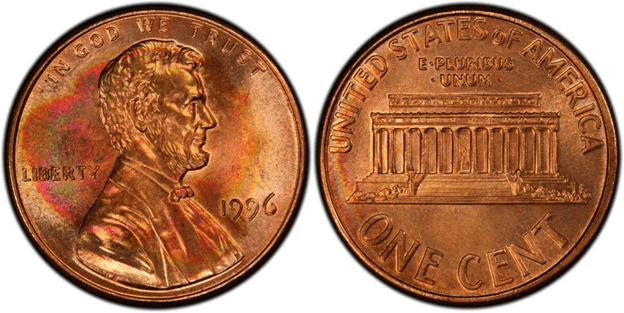
Most one-cent coins minted in the 1990s are fairly common since billions exist. That’s why you should be able to find a 1996-P Lincoln penny easily.
1996 S Proof Lincoln Penny
Edge: Plain
Mint Mark: S
Place of minting: San Francisco
Year of minting: 1996
Face Value: $0.10 (ten cents)
Price: $0.01 to $0.35 (circulated condition)
Quantity produced: 2,525,265
Designer: Victor David Brenner (obverse)/Frank Gasparro (reverse)
Composition: 95% copper, 5% zinc
Mass: 2.50 grams
Diameter: 19.00 millimeters
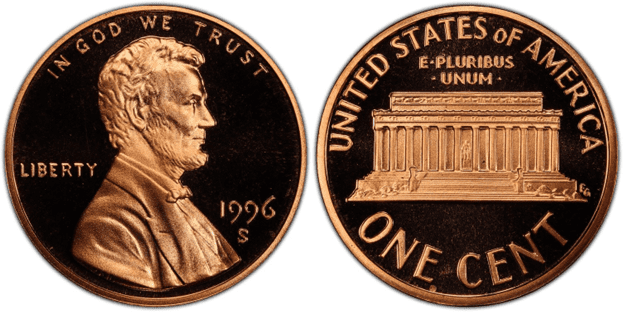
There were more than 2.5 million proof pennies in 1996. These special coins are made carefully to ensure they show more details on their surface. Proof coins aren’t meant for circulation but for collectors.
List Of 1996 Lincoln Penny Errors
With billions of Lincoln pennies released in 1996, it’s no surprise that some were struck with error. Now, you may think that error coins are all bad news. However, that’s not correct. Did you know that some of the most popular and expensive Lincoln pennies are error coins?
That’s why you should take a look at the following error coin examples for the 1996 penny:
Die break
There are times when the die breaks due to wear and tear. The die doesn’t break completely. It will just develop small cracks. When the die hits the planchet, the die also imprints the crack on the blank coin. As a result, you’ll find some unnecessary lines on the coin’s surface.
Here’s an example of a 1996 penny with a die break error:
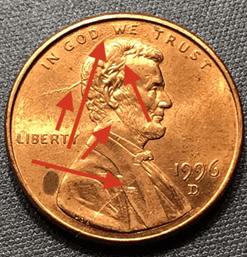
Doubled die error
Doubled die error can happen on the reverse, and it’s called DDO. If it’s on the reverse, it’s called DDR.
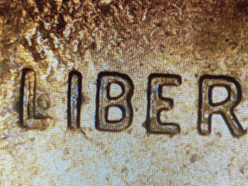
When the die hits the planchet twice, it creates a doubling effect on the coin. Not all DDRs or DDOs are easy to identify. You would need a microscope or magnifying glass to find the error. However, if you find a doubled die 1996 penny with prominent doubling, it can be sold for several dollars.
Strike-through error
A strike-through error can cause some distortions on the surface of the coin. This happens when a foreign material gets stuck on the die or planchet. The foreign material can be anything from dust and grease to dirt and metal clippings.
Here’s an example of a strike-through error on a 1996 penny:
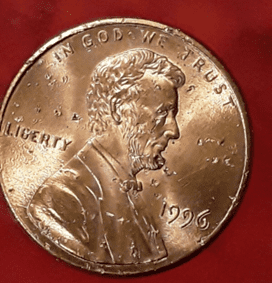
Broadstrike error
The die collar ensures the planchet won’t move when the die hits the blank coin. The problem is when the die collar becomes loose. There would be nothing to prevent the planchet from spreading outward.
Here’s an example of a broadstrike error on a 1996 penny:
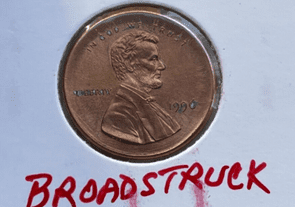
Rotated double strike error
This error is like a doubled strike error. However, the second strike was hit from a different angle. Take a look at this example:
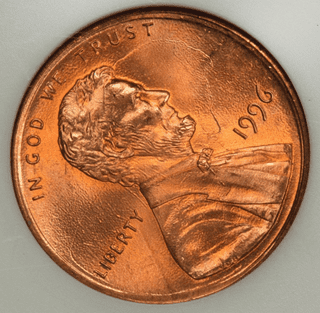
You can see that there’s like a shadow of Lincoln in the background. That’s the weaker strike. This error is quite unique. An owner sells this coin for about $500 on eBay.
How Much Is the 1996 Lincoln Penny Worth Today?
The 1996 Lincoln penny is affordable if you base your pricing on its melt value ($0.0081) and face value ($0.01). The circulated 1996 Lincoln penny is even just less than 50 cents.
Nevertheless, you will be pleasantly surprised to know that there are a lot of 1996 more valuable pennies.
Here’s a table that lists the auction records for each 1996 penny variety:
| Coin | Condition | Grade | Sold date | Sold by | Value |
| 1996 P Lincoln Penny | Superb Gem Uncirculated | MS 67+ (Red) | August 21, 2018 | eBay | $2,500 |
| 1996 D Lincoln Penny | Superb Gem Uncirculated | MS 69 – (Red) | November 1, 2008 | Bowers & Merena | $3,565 |
| 1996 S Proof Lincoln Penny | Perfect Uncirculated | PR 70 (Cameo) | July 26, 2003 | Heritage Auctions
|
$1,610 |
How Does The Grading System Work?
The grading system for the 1996 penny works by using the Sheldon Scale.
Professional numismatists joined in the 1970s and established CoinGrading standards, known as the Sheldon Scale. These numismatists now assign grades at key places on the seventy-point scale, using the most regularly utilized numeric points in conjunction with the original adjective grade. The following are the most common coin grades:
- (P-1) Poor – Indistinguishable and probably damaged; if used, must have a date and mintmark; otherwise, rather battered.
- (FR-2) Fair – Nearly smooth, but without the damage that a coin graded Poor often possesses. The coin must have enough detail to be identified.
- (G-4) Fair – Inscriptions have merged into the rims in some areas, and important elements have been mostly erased.
- (VG-8) Very Good- A little weathered, but all primary design elements are visible, albeit faintly. There is little, if any, central detail left.
- (F-12) Good – The item is very worn, yet the wear is even, and the overall design details stand out clearly. Rims are almost completely isolated from the field.
- (VF-20) Very Fine – Moderately weathered, with some finer features still visible. The motto or all letters of LIBERTY are readable. Both sides of the coin have entire rims separated from the field.
- (EF-40) Extremely Fine – Gently used; all gadgets are visible, and the most important ones are bold. The finer details are bold and clear; however, light wear may be seen.
- (AU-50) Uncirculated – Slight evidence of wear on the coin’s design’s high points; it may have contact marks; eye appeal should be adequate.
- (AU-58) Uncirculated Choice – Slight traces of wear, no severe contact marks, almost full mint shine, and great eye appeal.
- (MS-60) Mint State Basal – Strictly uncirculated; no indication of wear on the coin’s highest points, but an unsightly coin with reduced luster, visible contact marks, hairlines, and other flaws.
- (MS-63) Mint State Acceptable – Uncirculated, but with contact scratches and nicks, little reduced shine, but otherwise appealing appearance. The strike is weak to average.
- (MS-65) Mint State Choice – Uncirculated with great mint shine, little contact blemishes, and exceptional eye appeal. The strike is unusually severe.
- (MS-68) Mint State Premium Quality – Uncirculated with superb luster, no obvious contact marks to the naked eye, and exceptional eye appeal. The strike is quick and appealing.
- (MS-69) Almost Perfect Mint State – Uncirculated with perfect brilliance, a sharp and appealing strike, and extremely good eye appeal. A near-perfect coin with minor imperfections in the planchet, strike, and contact markings (seen only under 8x magnification).
- (MS-70) Mint State Perfect – Under 8x magnification, no tiny imperfections are discernible; the strike is crisp, and the coin is perfectly centered on a beautiful planchet. Rarely seen on a coin, this coin is bright and whole, with original luster and exceptional eye appeal.
Aside from that, the appraiser would also designate adjectives to describe your 1996 penny. These adjectives include but are not limited to Uncirculated, Circulated, Fine, Good, and Poor.
Moreover, a Lincoln penny’s value can increase based on its color. The redder the color is, the higher its value.
A 1996 penny can also be categorized as MS (Mint State) or PR (Proof). MS is given to coins originally made for the use of the general public. On the other hand, PR is given to coins that were made for collectors.
Where To Buy Or Sell 1996 Lincoln Penny?
The 1996 Lincoln one-cent penny is available in coin shops, antique stores, and pawnshops. There are also times when coins are available through auctions.
Aside from that, you can get in touch with the US Mint and coin grading service providers. They can also give you tips on finding your needed coins. PCGS also has authorized coin dealers nationwide.
If you can, try to join clubs, groups, and forums of people who collect coins. The more people you know, the more information you’ll get on how you can buy or sell a 1996 Lincoln Penny.
Moreover, if you are techy, you can try selling or buying a 1996 1-cent coin online. You’ll find a lot of websites and online marketplaces that could help you.
FAQs
Is there a 1996 wide Am penny?
Yes, there are 1996 pennies called wide AM pennies. These 1996 pennies have the letters A and M in the word America somewhat far from each other. Compare that to the close AM variety with the letters almost touching each other.
What makes a 1996 penny valuable?
The 1996 penny is valuable when rare and still in good condition. Moreover, if a 1996 penny receives a grade of at least MS68, it should be more valuable than other ordinary coins.
How much is a 1996 silver penny worth?
The US Mint didn’t produce any silver penny in 1996. So, you won’t find any. If you do, that would be valuable because it is extremely rare. Having a 1996 silver penny could give you thousands of dollars.
